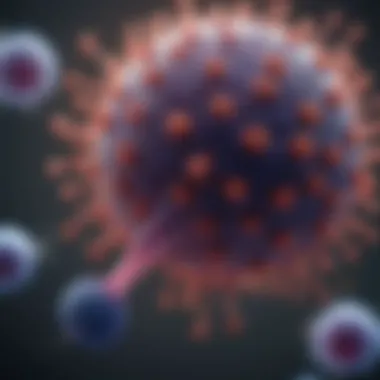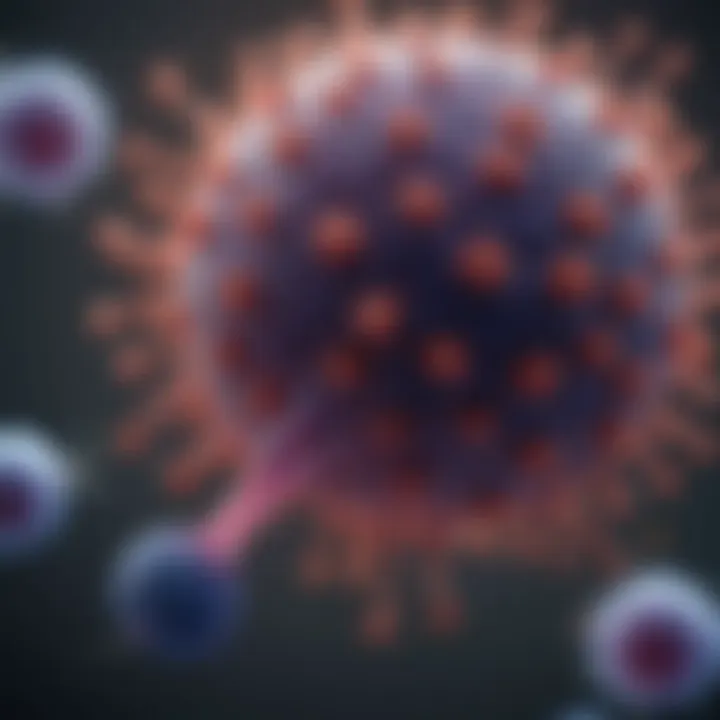T Cell CAR T Therapy: Mechanisms and Future Directions


Intro
Chimeric Antigen Receptor T Cell (CAR T) therapy represents a transformative advance in immuno-oncology. By engineering T cells to express specific receptors that target cancer cells, this therapeutic approach has shown remarkable potential in treating certain malignancies. Understanding this process involves delving into the intricate mechanisms underpinning CAR design, the various clinical applications across a range of cancers, and the challenges inherent in its implementation. This article will provide a detailed exploration of these aspects while also considering future directions and ethical implications of CAR T therapy.
Research Overview
Summary of Key Findings
Research into CAR T therapy has unveiled promising results, particularly in hematological cancers. Notably, therapies such as Kymriah and Yescarta have achieved significant success in treating acute lymphoblastic leukemia and large B-cell lymphoma. Key findings from various studies suggest that:
- CAR T cells can persist long-term in patients, offering sustained anti-cancer effects.
- The specificity of CARs plays a crucial role in their effectiveness, allowing for targeted destruction of tumor cells while sparing normal cells.
- Challenges such as cytokine release syndrome and neurotoxicity remain, necessitating ongoing research for better management strategies.
Importance of the Research
The significance of CAR T research cannot be overstated. As traditional cancer treatments often come with severe side effects and variable efficacy, CAR T therapy provides new hope for patients whose cancers have not responded to conventional therapies. It opens pathways for personalized medicine, allowing treatments tailored to individual tumor profiles. Furthermore, understanding these therapies helps in addressing unmet medical needs and optimizing treatment strategies.
Methodology
Study Design
Various clinical trials have been designed to evaluate the efficacy and safety of CAR T therapy. These trials often include:
- Phase I studies to determine safety and optimal dosing.
- Phase II studies to assess efficacy in larger, diverse patient populations.
- Observational studies to monitor long-term effects and outcomes.
Data Collection Techniques
Data in CAR T studies is collected through several methods, including:
- Patient questionnaires and clinical assessments to gauge health outcomes.
- Laboratory tests to track changes in tumor markers and CAR T cell expansion.
- Imaging studies like PET scans to visualize tumor response.
Research in this field is dynamic, evolving rapidly as new findings emerge. This continuous exploration is essential not only for advancing treatment options but also for understanding the comprehensive landscape of cancer immunotherapy.
Preamble to T Cell CAR T Therapy
T Cell CAR T therapy represents a significant advancement in cancer treatment, particularly in its ability to harness the immune system's potential. The growing body of research and clinical success highlights the importance of understanding this therapy's principles and applications. Uncovering the mechanisms of CAR T cells can shed light on their effectiveness in targeting malignancies that have been previously challenging to treat.
Defining CAR T Therapy
Chimeric Antigen Receptor (CAR) T cell therapy is an innovative form of immunotherapy that involves modifying a patient’s own T cells to recognize and attack cancer cells. In essence, T cells, a type of white blood cell, are engineered to express synthetic receptors that are specific to cancer-associated antigens. This targeted approach contrasts with traditional therapies, which can often affect both healthy and cancerous cells indiscriminately.
The process typically involves collecting T cells from a patient through a procedure known as leukapheresis. Once collected, these cells are genetically engineered to express CARs. After this modification, the T cells are expanded in the laboratory and infused back into the patient, where they can seek out and eliminate the targeted cancer cells. The precision of CAR T therapy offers the potential for higher efficacy with fewer side effects compared to more conventional treatments such as chemotherapy or radiation.
Historical Context
The evolution of CAR T therapy can be traced back to the early 1990s. Initial studies focused on the basic idea of modifying immune cells to enhance their capacity to fight cancer. However, it wasn't until the introduction of the first-generation CARs that real traction began. These early CARs used a single-chain variable fragment from antibodies to target specific antigens on cancer cells.
As of recent decades, an array of generations has been developed, enhancing both the effectiveness and safety profiles of CAR T therapies. The first significant breakthrough occurred in 2010 with the successful treatment of a patient with chronic lymphocytic leukemia, leading to a series of clinical trials and eventual approval of therapies like Kymriah and Yescarta for treating hematologic malignancies.
This historical context underlines a profound transformation in cancer treatment methodologies. From its conceptual beginnings to emerging practices, CAR T therapy illustrates a remarkable journey fueled by ongoing research and clinical innovations.
Mechanism of Action
The mechanism of action is central to understanding T Cell CAR T therapy. It encapsulates how modified T cells target and eliminate cancer cells, a process that is both fascinating and complex. Insight into this mechanism offers valuable information on the therapy's efficacy and the potential benefits and considerations when applying it clinically. Research and advancements in this area continue to evolve, impacting patient outcomes significantly.
T Cell Fundamentals
T cells are a type of white blood cell, vital to the immune response. They play an essential role in identifying and attacking infected or malignant cells. Two main types of T cells are involved in this process: helper T cells, which coordinate the immune response, and cytotoxic T cells, which directly kill abnormal cells. The capability of T cells to distinguish between healthy and unhealthy cells lies in their receptors. Each T cell carries unique receptors that recognize specific antigens, protein markers found on the surface of malignant cells. When a T cell encounters an antigen matching its receptor, it activates and proliferates. This intrinsic property of T cells underpins the rationale of CAR T therapy, where T cells are engineered for enhanced recognition and destruction of cancer cells.
Structure of CAR
The chimeric antigen receptor (CAR) itself is a recombinant protein designed to enhance T cell function. A CAR comprises an extracellular domain that recognizes antigens and an intracellular signaling domain that activates the T cells. The structure can vary significantly, incorporating elements from antibodies to improve target specificity. Generally, a CAR structure consists of:


- Antigen Recognition Domain: Typically derived from single-chain variable fragments (scFv) of antibodies, this domain binds directly to the targeted tumor antigen.
- Hinge Region: This segment provides flexibility between the antigen recognition domain and the transmembrane domain, facilitating optimal positioning for signaling.
- Transmembrane Domain: Anchors the CAR to the T cell membrane, ensuring stability and proper signaling.
- Intracellular Signaling Domains: Usually contain signaling motifs from co-stimulatory molecules such as CD28 or 4-1BB, which are crucial for T cell activation and survival.
The unique architecture of CAR allows it to directly engage tumor antigens, leading to enhanced T cell activity against malignancies.
T Cell Activation and Expansion
Once engineered and infused back into the patient, CAR T cells require activation to engage effectively in combating cancer. The activation process involves several key steps:
- Binding to Target Antigen: Upon encountering a cancer cell with the specific antigen, the CAR binds to it, initiating the activation process.
- Costimulatory Signals: The interaction with the antigen alone is not sufficient. Costimulatory signals from the CAR’s intracellular domains are necessary for full activation. Without these signals, T cell responses can diminish quickly.
- Proliferation and Cytotoxicity: Once activated, the CAR T cells proliferate rapidly. This expansion leads to a large number of T cells that can attack tumor cells. They release cytotoxic molecules that induce apoptosis in the targeted cancer cells.
- Memory Formation: Some activated CAR T cells transition into memory cells, enabling the immune system to respond more swiftly to any recurrence of the malignancy.
Overall, the mechanism of T Cell CAR T therapy relies on a sophisticated interplay between T cell biology and engineered receptor technology. The effectiveness of these therapeutic interventions hinges on understanding these intricate processes.
Types of CAR T Cells
The development of CAR T cells has led to a diverse range of cell therapies tailored for specific cancer types. Understanding the different generations of CAR T cells is vital for appreciating their mechanisms of action, clinical applications, and the ongoing improvements in immunotherapy. Each generation reflects advancements in technology, aimed at enhancing therapeutic outcomes while mitigating risks and limitations.
First-Generation CARs
First-generation CARs were the pioneers of chimeric antigen receptor technology. These CARs typically consist of an extracellular domain that recognizes a specific antigen, a transmembrane domain, and an intracellular signaling domain derived from the CD3 zeta chain. The simplicity of this design, while revolutionary, presented challenges in efficacy. Early clinical trials revealed that these CARs often failed to induce sustained T cell activation and proliferation.
The inherent limitations of first-generation CARs prompted research into enhancing their functionality.
Although their performance was suboptimal, first-generation CAR T cells laid the groundwork for understanding how T cells can be genetically engineered. Moreover, these early studies established the framework for safety evaluations and set the stage for more complex iterations.
Second-Generation CARs
Second-generation CARs introduced additional signaling domains to improve T cell activation. Most notably, the inclusion of co-stimulatory domains, like CD28 or 4-1BB, significantly enhanced the proliferation, survival, and cytokine secretion of T cells. This modification proved crucial in addressing the limitations of first-generation CARs.
The improved activation of second-generation CARs allowed for greater anti-tumor responses, especially in hematologic malignancies such as leukemia and lymphoma. Clinical trials showed higher remission rates, making these formulations more favorable for patient use. However, even with these advancements, challenges still existed in targeting solid tumors.
Third-Generation CARs
Third-generation CARs represent the most advanced stage in CAR T cell therapy. These CARs integrate two co-stimulatory signaling domains, further amplifying T cell activation and function. By combining signals from co-stimulatory molecules, third-generation CARs exhibit enhanced durability and persistence within the hostile tumor microenvironment.
The complexity of third-generation designs results in a significant leap in therapeutic potential, particularly for difficult-to-treat cancers. While still under investigation, these CARs show promise in clinical trials targeting both hematologic malignancies and solid tumors. The next steps will involve not only optimizing these CAR constructs but also developing strategies to overcome existing issues, such as antigen variation and the immunosuppressive tumor microenvironment.
In summary, the evolution of CAR T cells from first to third generation highlights the rapid advancements in cancer immunotherapy. Each type has unique characteristics that address specific needs, demonstrating the importance of continuous research in the field to ultimately benefit patients.
Clinical Applications of CAR T Therapy
The clinical applications of CAR T therapy represent a significant advancement in the treatment of various malignancies, particularly hematologic cancers. This therapy provides a personalized approach, utilizing the patient’s own T cells to fight cancer. Its importance lies not only in treating existing cancers but also in improving the quality of life for patients who may have exhausted other treatment options. By leveraging the power of the immune system, CAR T therapy opens new avenues for treatment, showing efficacy that traditional methods may not achieve.
Hematologic Malignancies
Hematologic malignancies include blood cancers such as leukemia and lymphoma. The unique biology of these cancers makes them suitable targets for CAR T therapy.
Acute Lymphoblastic Leukemia
Acute Lymphoblastic Leukemia (ALL) is a type of cancer that primarily affects young children and presents rapidly. The significance of targeting ALL with CAR T therapy lies in its generally high response rate. Therefore, it is a prominent focus within this article. One key characteristic of ALL is the presence of specific surface antigens, such as CD19, that can be targeted by CAR T cells.
CAR T therapy for ALL has shown remarkable results, with many patients achieving remission even after failing multiple lines of treatment. This unique aspect showcases the therapy's capability to reprogram the immune system effectively.
However, potential disadvantages include the risk of cytokine release syndrome, which could lead to severe complications for patients. Balancing the efficacy of CAR T therapy against its risks is essential for further research and clinical applications.
Diffuse Large B-Cell Lymphoma
Diffuse Large B-Cell Lymphoma (DLBCL) is one of the most common aggressive lymphomas. It is vital in the context of CAR T therapy due to its heterogeneous nature. The specific aspect of DLBCL relevant to this article is its responsiveness to CAR T therapy, particularly when CD19 is targeted.
The key characteristic of DLBCL lies in its varied genetic profiles, which can complicate treatment outcomes. Despite these challenges, CAR T therapy remains a beneficial choice due to its ability to target the tumor cells effectively.
The unique feature of CAR T therapy in DLBCL is its potential to result in complete remission in many cases. Nevertheless, this treatment can incur side effects such as neurotoxicity, which researchers and clinicians must consider carefully.
Solid Tumors


Solid tumors represent another frontier for CAR T therapy, posing different challenges than hematologic malignancies. Although there have been advancements, targeting solid tumors remains a complex endeavor.
Challenges in Targeting Solid Tumors
One of the primary challenges in targeting solid tumors with CAR T therapy is the immunosuppressive tumor microenvironment. Unlike blood cancers, solid tumors create barriers that prohibit effective CAR T cell infiltration. This aspect makes it less favorable for CAR T treatments to show the same effectiveness as in hematologic cancers.
Additionally, solid tumors often exhibit antigen heterogeneity. Each patient may have a unique set of tumor antigens, complicating the design of a universal CAR T therapery. The unique feature here lies in developing strategies to overcome these obstacles, which remains a crucial area of research in the field.
Recent Clinical Trials
Recent clinical trials exploring CAR T therapy for solid tumors are vital steps towards understanding its potential. These trials focus on targeted delivery methods and combinations with other therapies.
The key characteristic of these clinical trials is their efforts to identify effective subgroups and improve treatment methodologies. They help inform best practices for implementing CAR T therapy in solid tumors, although it remains a challenging domain.
The unique feature of these trials is their focus on overcoming previous barriers that CAR T therapy faced. Successes in this area may lead to breakthroughs that could further validate the use of CAR T therapy across a broader spectrum of cancer types.
"The future applications of CAR T therapy could redefine cancer treatment across multiple disciplines as it expands beyond blood cancers."
The clinical applications of CAR T therapy exemplify both progress and challenge within cancer treatment. As researchers continue to explore this landscape, the establishment of robust treatments for both hematologic malignancies and solid tumors can pave the way for enhanced patient outcomes. The emphasis on special characteristics of specific cancers assists in understanding not just the triumphs but also the potential obstacles moving forward.
Challenges Faced in CAR T Therapy
The field of CAR T therapy, while promising, encounters significant challenges that impact its clinical utility and overall effectiveness. Understanding these obstacles is crucial for both researchers and clinicians as they strive to refine this cutting-edge treatment modality. Addressing these challenges can enhance patient outcomes and broaden the applicability of CAR T therapy in combating a wider range of malignancies.
Cytokine Release Syndrome
Cytokine Release Syndrome, or CRS, emerges as a major complication of CAR T therapy. It occurs when activated T cells release large quantities of cytokines into the bloodstream. This can trigger a cascade of inflammatory responses leading to a spectrum of symptoms, ranging from mild flu-like feelings to severe life-threatening conditions.
The precise mechanism behind CRS involves the release of pro-inflammatory cytokines such as interleukin-6 (IL-6) and TNF-alpha. This exaggerated immune response can lead to complications like high fever, hypotension, and multi-organ dysfunction. Recognizing and managing CRS is critical. Healthcare providers often employ anakinra or tocilizumab as treatments to mitigate the effects of this syndrome.
Caution must be exercised in predicting who might experience severe CRS, as current biomarkers are limited. The intricacies of individual patient responses necessitate ongoing research to identify reliable predictive factors.
Neurotoxicity
Neurotoxicity is another significant concern associated with CAR T cell therapies. Symptoms can range from mild confusion to severe neurological complications, such as seizures or encephalopathy. This syndrome is less understood compared to CRS, making it challenging for clinicians to predict its onset or intensity.
The underlying mechanisms may involve the migration of CAR T cells into the central nervous system, allowing them to act on neurons or supportive cells adversely. The resulting condition complicates treatment regimens, as it can lead to prolonged hospital stays and additional interventions.
Currently, managing neurotoxicity often focuses on supportive care, and determining appropriate measures to prevent its occurrence is a substantial area for future research.
Antigen Escape
Antigen escape presents another critical issue for CAR T therapy. Cancer cells can evolve over time, leading to the downregulation or complete loss of the targeted antigen on the surface of these malignant cells. This adaptation enables the tumor to evade detection and elimination by CAR T cells, which specifically target those antigens.
The implications of antigen escape are profound. Patients may initially respond well to treatment, but the durability of that response can be significantly compromised. To combat this issue, research is ongoing to identify new antigens or combinations of antigens that can be targeted simultaneously.
Strategies like dual-targeting CARs aim to minimize the risk of antigen escape by recognizing multiple epitopes, thus improving the chances of sustained therapeutic success.
Future of T Cell CAR T Therapy
The future of T Cell CAR T therapy is critical in the continuing evolution of cancer treatment. As research progresses, the potential for improvements in patient outcomes becomes clearer. Addressing both efficacy and accessibility will be key to maximizing the benefits of this innovative approach.
Improving Efficacy
Improving the efficacy of CAR T therapy is a top priority. Current treatments show success in certain malignancies but face limitations. New strategies to enhance the activity of T cells are being explored. These include advancements in CAR design, optimized signaling domains, and gene-editing technologies.
The main characteristic of improving efficacy lies in the customization of CAR constructs to better target specific tumor antigens. As researchers identify novel targets, therapy could become more effective across various cancers. Each breakthrough in this process can lead to better survival rates and quality of life for patients.
Expanding Accessibility
Expanding accessibility to CAR T therapy addresses the disparity in treatment options available to patients. This is especially relevant in regions with limited resources. Efforts are underway to democratize access to these therapies.


Cost-Effectiveness
Cost-effectiveness of CAR T therapies plays a substantial role in broadening reach. Notably, high upfront costs remain a barrier. However, studies suggest that CAR T can lead to long-term savings through reduced hospitalization and less need for follow-up treatments.
The uniqueness of cost-effectiveness comes from the potential to shift perceptions on investment in CAR therapies. Lower costs could promote acceptance from both healthcare providers and payers. While some argue costs might deter advancements, improvements in production methods could help reduce financial barriers in the future.
Logistical Challenges
Logistical challenges are essential in the discussion of accessibility. The process of manufacturing CAR T cells is complex and requires advanced infrastructure. Shipping and transport of these cells can also present difficulties.
The key feature of these challenges includes the timing and location of treatment. Each patient’s cells must be collected and then effectively reintroduced into the body. The risk of delays can hinder timely treatment. Enhancing the logistical framework is vital for improving patient outcomes across various health systems.
Innovative Approaches
Looking ahead, innovative approaches can further transform CAR T therapy. These strategies not only aim to improve effectiveness and accessibility but also to address limitations seen in current applications.
Universal CAR T Cells
Universal CAR T cells represent a promising avenue in treatment evolution. By using off-the-shelf products, this approach attempts to eliminate the need for individualized preparation. The biological feature of these cells allows them to target multiple types of cancer.
Advantages of universal CAR T cells include faster availability and lower costs compared to personalized options. However, there remain concerns about potential immune reactions and efficacy against different tumor types. Continued research will be necessary to overcome these challenges and optimize outcomes.
Combination Therapies
Combination therapies integrate CAR T approaches with other treatments to enhance outcomes. For example, pairing CAR T therapy with checkpoint inhibitors could boost the anti-tumor response.
The key attribute of combination therapies lies in their potential to address resistance mechanisms. By simultaneously attacking cancer cells from multiple fronts, these strategies may improve long-term patient survival. Yet, the complexity of managing multiple treatment regimens must be addressed to minimize adverse effects.
In summary, the future of T Cell CAR T therapy holds great promise. Through continued exploration of efficacy, accessibility, and innovative methods, it seems likely that this groundbreaking treatment will become more effective and widely available. This ongoing research is essential to realizing the full potential of CAR T therapy in cancer treatment.
Ethical Considerations in CAR T Therapy
Ethical considerations are an essential aspect of T Cell CAR T therapy. As this innovative treatment continues to develop and is increasingly used in clinical settings, it raises significant moral questions. These concerns revolve around the preservation of patient autonomy, the equitable distribution of resources, and the potential consequences of novel medical interventions. Understanding these ethical dimensions is crucial not only for healthcare practitioners but also for patients and their families as they navigate treatment options.
Informed Consent
Informed consent is a cornerstone of ethical medical practice, particularly in advanced therapies like CAR T therapy. Patients must have a clear understanding of what the treatment entails. This includes its mechanisms, potential benefits, risks, and the uncertainties involved. Nurses and physicians should explain complexity of the CAR T process, emphasizing how T cells are modified and reintroduced to combat cancer. Patients need enough information to make informed choices about their health.
Even with innovative treatments, challenges arise. Some patients may feel overwhelmed by the medical jargon or complex scientific data. Thus, it is crucial to adopt clear and comprehensible language. Facilitating open discussions can help patients address their concerns and clarify any doubts.
Moreover, healthcare providers must ensure that patients are not coerced into participating in clinical trials or treatment protocols. It is vital that they understand they have the right to decline treatment without negative repercussions.
Equity in Access
Equity in access to CAR T therapy is another pressing ethical issue. While the treatment has shown remarkable success rates for certain malignancies, disparities remain significant in its availability. Economic factors, geographic limitations, and healthcare infrastructure play a big role in determining patient access to this therapy.
- Cost-Effectiveness: The high cost of CAR T therapy often excludes certain patient populations. Insurance coverage may vary, leading to inequities in treatment access. Providers must work diligently to advocate for financial options that allow more patients to benefit from these groundbreaking therapies.
- Logistical Challenges: Transportation to specialized treatment centers can be a barrier for patients living in rural areas. Creating outreach programs might be a solution to make access more equitable.
Consideration for equitable access drives ongoing discussions about how society values medical innovations. Striving for inclusivity ensures all patients have a fair chance at receiving effective treatments like CAR T therapy.
The End
In summary, T Cell CAR T therapy represents a significant development in cancer treatment. The mechanisms underlying this therapy involve engineering T cells to express chimeric antigen receptors, enabling precise targeting of malignant cells. This innovation is not just a treatment but a transformation of the therapeutic landscape in oncology.
Summary of Key Points
- Mechanisms of Action: CAR T therapy modifies T cells to recognize and destroy cancer cells effectively.
- Types of CAR T Cells: Understanding first, second, and third-generation CARs is crucial for grasping the evolution and improvements in efficacy.
- Clinical Applications: While effective in hematologic malignancies, CAR T therapy faces challenges when applied to solid tumors.
- Challenges: Conditions like cytokine release syndrome and neurotoxicity highlight the need for ongoing research.
- Future Directions: Enhancements in efficacy, accessibility, and innovative combinations are necessary to widen the therapeutic reach of CAR T therapies.
- Ethical Considerations: Informed consent and equal access are crucial in addressing the societal impacts of this advanced therapy.
These elements illustrate the multifaceted nature of CAR T therapy. It sheds light on the therapy's advantages and the hurdles that remain.
Final Thoughts on CAR T Therapy
CAR T therapy stands at the forefront of immunotherapy. Its development signifies hope for many patients with cancers previously deemed untreatable. Yet, the evolving landscape involves rigorous scrutiny regarding ethical practice and equitable access to this treatment.
As healthcare professionals and researchers move forward, the continuous examination of CAR T therapy's effectiveness and safety can reshape future oncology practices. Innovations in this field will have lasting implications, potentially leading to a new standard in cancer treatment options.
"The future of CAR T therapy relies on balancing innovation with responsibility to ensure that its benefits reach all populations equitably."
Ultimately, the journey for CAR T therapy is just beginning, and contributions from diverse fields will propel this science into a hopeful future for cancer patients.



